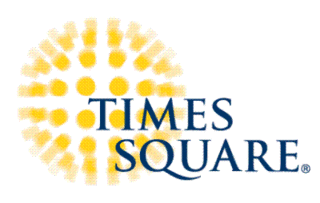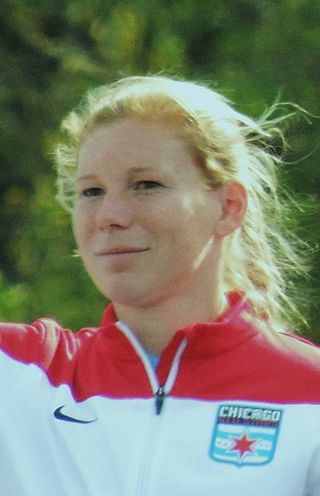
Broadway is a road in the U.S. state of New York. Broadway runs from State Street at Bowling Green for 13 mi (20.9 km) through the borough of Manhattan, over the Broadway Bridge, and 2 mi (3.2 km) through the Bronx, exiting north from New York City to run an additional 18 mi (29.0 km) through the Westchester County municipalities of Yonkers, Hastings-On-Hudson, Dobbs Ferry, Irvington, Tarrytown, and Sleepy Hollow, after which the road continues, but is no longer called "Broadway". The latter portion of Broadway comprises a portion of U.S. Route 9.

Gertrude Caroline Ederle was an American competition swimmer, Olympic champion, and world record-holder in five events. On August 6, 1926, she became the first woman to swim across the English Channel. Among other nicknames, the press sometimes called her "Queen of the Waves".

Grover Aloysius Whalen (1886–1962) was a prominent politician, businessman, and public relations guru in New York City during the 1930s and 1940s.

Ticker tape was the earliest electrical dedicated financial communications medium, transmitting stock price information over telegraph lines, in use from around 1870 through 1970. It consisted of a paper strip that ran through a machine called a stock ticker, which printed abbreviated company names as alphabetic symbols followed by numeric stock transaction price and volume information. The term "ticker" came from the sound made by the machine as it printed.

Confetti are small pieces or streamers of paper, mylar, or metallic material which are usually thrown at celebrations, especially parades and weddings. The origins are from the Latin confectum, with confetti the plural of Italian confetto, small sweet. Modern paper confetti trace back to symbolic rituals of tossing grains and sweets during special occasions, traditional for numerous cultures throughout history as an ancient custom dating back to pagan times, but adapted from sweets and grains to paper through the centuries. Confetti are manufactured in multiple colors, and commercially available confetti come in many different shapes. A distinction is made between confetti and glitter; glitter is smaller than confetti and is universally shiny. Most table confetti is also shiny. While they are called metallic confetti they are actually metallized PVC. Most party supply stores carry paper and metallic confetti. Confetti are commonly used at social gatherings such as parties, weddings, and Bar Mitzvahs. The simplest confetti are simply shredded paper, and can be made with scissors or a paper shredder. Chads punched out of scrap paper are also common. A hole punch makes small round chads, and a ticket punch makes more elaborate chads. Most pieces of paper flats will flutter as tumblewings giving long flight times.

Three Chrysler Imperial Parade Phaetons were produced in 1952 by Chrysler as ceremonial vehicles. They were styled by Virgil Exner and were in many ways a preview of the new "100 Million Dollar" styling that would debut in 1955 on the newly separate Imperial marque and on other full-size Chrysler Corporation Cars.

Ricardo Julio Villa, more commonly known as Ricky Villa, is an Argentine football coach and former professional midfielder. He was famous for his time playing football from 1970 to 1989.

Shannon Leigh Boxx Spearman is an American retired soccer player and former member of the United States women's national soccer team, playing the defensive midfielder position. She last played club soccer for the Chicago Red Stars in the American National Women's Soccer League. She won gold medals with the United States at the 2004 Athens Olympics, 2008 Beijing Olympics, and 2012 London Olympics. She has also finished third place or better with the US at the 2003, 2007, 2011 and 2015 FIFA Women's World Cups. She was a finalist for the 2005 FIFA World Player of the Year award, and won an NCAA Women's Soccer Championship with Notre Dame in 1995. Shannon Boxx announced her retirement from international and club soccer after winning the 2015 FIFA Women's World Cup. She played her last game on October 21, 2015, when the USWNT tied with Brazil as part of their victory tour.

The Times Square Ball is a time ball located in New York City's Times Square. Located on the roof of One Times Square, the ball is a prominent part of a New Year's Eve celebration in Times Square commonly referred to as the ball drop, where the ball descends down a specially designed flagpole, beginning at 11:59:00 p.m. ET, and resting at midnight to signal the start of the new year. In recent years, the ball drop has been preceded by live entertainment, including performances by musicians. Over 1,000,000 people from around the world attend.

Christie Patricia Pearce is an American former professional soccer player who played as a defender. She is the former captain of the United States national team. Pearce is a three-time Olympic gold medalist, and also a two-time world champion in FIFA Women's World Cup.

Harold Charles Gatty was an Australian navigator and aviation pioneer. Charles Lindbergh called Gatty the "Prince of Navigators." In 1931, Gatty served as navigator, along with pilot Wiley Post, on the flight which set the record for aerial circumnavigation of the world, flying a distance of 15,747 miles (24,903 km) in a Lockheed Vega named the Winnie Mae, in 8 days, 15 hours and 51 minutes.

Lori Christine Chalupny Lawson is a former American soccer defender who last played for the Chicago Red Stars and the United States women's national soccer team. She is a gold medalist from 2008 Beijing Olympics, and a bronze medalist in 2007 FIFA Women's World Cup hosted by China. She was also on the roster of the United States national soccer team for the 2015 FIFA Women's World Cup in Canada. She is the current head woman's soccer coach of Maryville University in St. Louis.

Lieutenant General Withers Alexander Burress was United States Army officer who was a graduate and commandant of the Virginia Military Institute as well as a combat commander in World War I and World War II.

The 1978 FIFA World Cup final was a football match played to determine the winner of the 1978 FIFA World Cup. The match was contested by hosts Argentina and the Netherlands, in the biggest stadium used in the tournament and in Argentina, the Estadio Monumental in the Argentine capital city of Buenos Aires. The match was won by the Argentine squad in extra time by a score of 3–1. Mario Kempes, who finished as the tournament's top scorer, was named the man of the match. The Netherlands lost their second World Cup final in a row, both times to the host nation, after losing to West Germany in 1974. This was also the second World Cup tournament in a row won by the host nation. It was the only World Cup final between 1950 and 2002 that did not feature Germany or Brazil.

Alyssa Michele Naeher is an American professional soccer player who plays as a goalkeeper for National Women's Soccer League club Chicago Red Stars and the United States Women's National Team. She was on the 23-player roster for the United States at the 2015 FIFA Women's World Cup and was the starting goalkeeper for the U.S. at the 2019 FIFA World Cup in France. She has also played for the Boston Breakers and Turbine Potsdam. With the Breakers, she won the 2014 NWSL Goalkeeper of the Year award.

Meghan Elizabeth Klingenberg is an American professional soccer player who plays as a defender for Portland Thorns in the National Women's Soccer League (NWSL). A former member of the United States women's national soccer team, she is a one-time FIFA Women's World Cup champion. She has also played for three teams in the Women's Professional Soccer (WPS) league, for Tyresö FF in Sweden's Damallsvenskan and for the Houston Dash in the NWSL.

The 2015 FIFA Women's World Cup final was a women's soccer match that took place on 5 July 2015 at BC Place, in Vancouver, British Columbia, Canada, to determine the winner of the 2015 FIFA Women's World Cup. It was played between Japan and the United States, in a rematch of the 2011 final. The stakes were high for both sides: if the United States won the match, it would be the only country to have won in three Women's World Cup finals; if Japan had won instead, then it would be the first team, men's or women's, to win twice under the same coach since Vittorio Pozzo led Italy to victory in the 1934 World Cup and the 1938 World Cup. Ultimately, the United States won 5–2, winning its first title in 16 years and becoming the first team to win three Women's World Cup finals.
Giles Chester Stedman (1897–1961), Rear Admiral and a recipient of the Navy Cross, was the 2nd Superintendent of the United States Merchant Marine Academy at Kings Point, New York. The son of an Ireland born stonecutter, who worked in Quincy, Massachusetts' granite quarries, Stedman enlisted in the United States Coast Guard in 1917 at the age of 20. He was assigned to the USCGC Ossipee (WPR-50). At outbreak of WWI, the ship and its crew were transferred to the US Navy and saw overseas action. Stedman was awarded the World War I Victory Medal for his service. In 1919, he was commissioned an ensign in the United States Naval Reserve. Stedman, thereafter, entered the merchant marine, licensed as a ship's Third mate or 3rd officer.

The Lafayette Welcoming Parade of 1824 was a parade held in New York City on August 16, 1824, to welcome the arrival of the Marquis de Lafayette on the occasion of his visit to the United States for a sixteen-month tour. It has been described as the first triumphal parade in New York history.




















